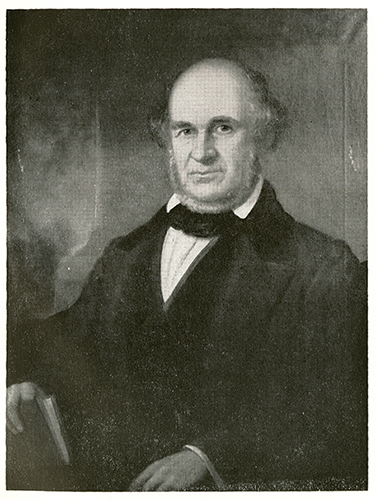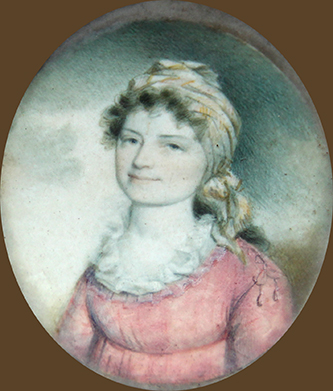17 Apr. 1795–11 May 1866

George Edmund Badger, superior court judge, secretary of the navy, and U.S. senator, was born in New Bern, the son of Thomas and Lydia Cogdell Badger. His father was a native of Windham, Conn., who removed to New Bern when a young man. In 1793, Thomas married the daughter of Richard Cogdell of New Bern, and George Edmund was the eldest of three children. He received his secondary education in New Bern. In 1810 he entered Yale College, where he remained for only two years because of a lack of funds. Returning to New Bern, he studied law under his maternal cousin, John Stanley, and was licensed to practice in 1815.
Throughout his life, Badger was a devoted member of the Episcopal church. From 1825 until his death he was an active member of Christ Church, Raleigh, frequently serving on its vestry and several times representing the parish in diocesan conventions.
Badger served as a trustee of The University of North Carolina from 1818 to 1844. One of his important accomplishments as a trustee was the introduction of a resolution calling for the establishment of a chair of modern languages. As a result of the resolution, a professor of modern languages was employed in 1826. In appreciation of his services to the university and in recognition of his intellectual attainments, the university conferred on him the LL.D. degree in 1834. His alma mater, Yale College, awarded him the LL.D. in 1848.
Badger was elected a member of the House of Commons from the borough of New Bern in 1816. Four years later he was elected a judge of the superior court, serving in this office until he resigned in 1825 to practice law in Raleigh; there he made his home until his death. His first active participation in national politics was in the presidential campaign of 1828, when he supported the candidacy of Andrew Jackson. He was a member of the state Central Jackson Committee, writing the two most important pamphlets it issued in Jackson's interest. In recognition of his work, the Democratic party of North Carolina nominated Badger as its choice for the cabinet post of attorney general. The party's recommendation was passed over by Jackson, who instead appointed John Branch of North Carolina, then serving in the Senate, as secretary of the navy. A few years later, Badger broke with Jackson on the question of the recharter of the Bank of the United States and aligned himself with the newly formed Whig party, whose advocacy of internal improvements and a strong central government met with his hearty approval.
Badger played an active role in the presidential election of 1840. On 3 Mar. he delivered a speech in Granville County that was recognized as the platform of the Whig party of North Carolina. He also delivered the keynote address at the Whig state convention. In recognition of his work in the campaign of 1840, President-elect William Henry Harrison appointed him secretary of the navy; his appointment was confirmed by the Senate on 6 Mar.
After a careful study of the needs of the navy, Badger made a report to Congress recommending the establishment of a home squadron for the protection of the nation's coastline. This recommendation was enacted into law in July 1841, creating the nucleus of what was later the Atlantic fleet. In his second report on the navy, also accepted by Congress, Badger advocated the increase of naval ordnance as well as a fund for experimenting with and testing the value of improved ordnance. During his brief period as secretary of the navy, he encouraged new inventions for the improvement, especially in speed, of war vessels. In summing up his work in the Navy Department, the editor of the Philadelphia Inquirer and Daily Courier wrote: "We have been called upon by a number of officers of the Navy, as far as it has been ascertained, that never was the Department characterized by more efficiency, vigor, and ability than during the brief but brilliant administration of the Hon. Geo. E. Badger."
One month after his inauguration, President Harrison died. He was succeeded in office by Vice-President John Tyler. On 11 Sept. Badger and the other members of the cabinet, with the exception of Secretary of State Daniel Webster, resigned their posts because of Tyler's position on the establishment of a national bank: Tyler vetoed two different bills passed by Congress creating a national bank, one of the cherished measures of the Whig party. Senator William A. Graham of North Carolina wrote a friend that the secretaries had not deserted the president on account of a mere disagreement, "but for trifling and treachery towards them."

In 1846 the North Carolina legislature elected Badger to the U.S. Senate to fill the unexpired term of William H. Haywood, Jr. Two years later he was reelected for a regular six-year term. In the course of his senatorial career, Badger opposed the Mexican War and the Wilmot Proviso, supported the Compromise of 1850, worked actively for the passage of the Kansas-Nebraska bill, and sponsored measures for the improvement of the merchant marine. He was recognized in the Senate as a consistent defender of the constitution and an advocate of a strong central government. In January 1853, President Fillmore nominated Badger as an associate justice of the U.S. Supreme Court to fill the vacancy caused by the death of Justice John McKinley, who had presided over the Southwestern Circuit. The nomination aroused much hostile criticism from the Democrats, particularly from those of the lower South, who distrusted Badger's views on slavery and on centralized government. Badger was refused confirmation by a party vote of twenty-six to twenty-five; the single most important factor in the rejection was his residence outside the district. The senators from Alabama, Louisiana, and Mississippi were bitter in their opposition to the nomination.
In the fall of 1854, Badger was defeated for reelection to a legislature controlled by the Democrats. On the eve of his departure, 3 Mar. 1855, the Senate unanimously passed a resolution introduced by a Democrat expressing its appreciation " . . . for his uniform courtesy, ability, liberality, and valuable services during his long and distinguished career in this body." Such a tribute was unique at that time in the annals of the Senate.
From the time of his retirement from the Senate until 1860, Badger devoted most of his energy to the practice of law. Before leaving Washington he formed a law partnership with J. M. Carlisle, for the purpose of participating in cases before the court of claims and the U.S. Supreme Court. Upon returning to Raleigh in 1855, he was elected one of the county magistrates, an office he held for the next six years.
Badger's last appearances in public life were as an elector at large on the Bell and Everett ticket in the election of 1860 and as a delegate from Wake County to the Secession Convention of 1861. Throughout the sectional controversies of 1860 and early 1861, Badger maintained his position as a Union man, but when Lincoln called for volunteers for the invasion of the South, he joined with those favoring separation. When the convention met in Raleigh on 20 May 1861, Badger introduced "An Ordinance Declaring the Separation of North Carolina from the United States of America." The ordinance was based upon the right of revolution, carefully avoiding any reference to the theory of secession, a political concept he never acknowledged. Badger's proposal was rejected by the convention, which adopted a simple ordinance of secession from the Union introduced by Burton Craige.
Badger was first married in 1818 to Rebecca Turner, daughter of Governor James Turner. She died six years later without issue. In 1826 he married Mary Polk, daughter of Colonel William Polk, by whom he had two children: Catherine (b. 1827) and Sarah (b. 1833). Mary Polk Badger died in 1834. In 1836, Badger married a widow, Mrs. Delia Haywood Williams, daughter of Sherwood Haywood. They had seven children: Mary Rose (b. 1836), George Edmund (b. 1838), Richard C. (b. 1839), Annie H. (b. 1841), Thomas (b. 1843), Sherwood (b. 1844), and Edmund S. (b. 1846).